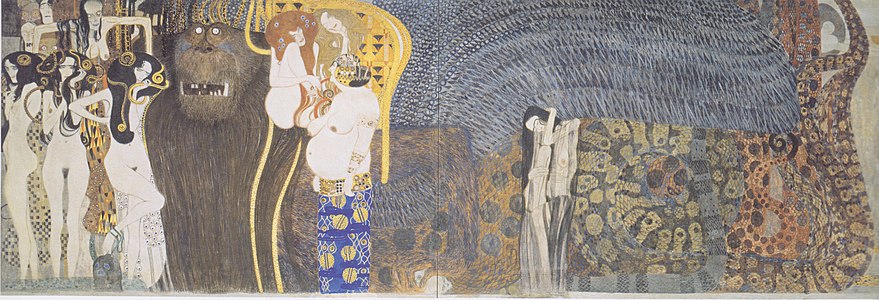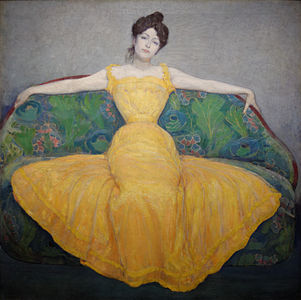
Vienna Secession
The Vienna Secession (German: Wiener Secession; also known as the Union of Austrian Artists or Vereinigung Bildender Künstler Österreichs) is an art movement, closely related to Art Nouveau, that was formed in 1897 by a group of Austrian painters, graphic artists, sculptors and architects, including Josef Hoffman, Koloman Moser, Otto Wagner and Gustav Klimt.[1] They resigned from the Association of Austrian Artists in protest against its support for more traditional artistic styles. Their most influential architectural work was the Secession exhibitions hall designed by Joseph Maria Olbrich as a venue for expositions of the group. Their official magazine was called Ver Sacrum (Sacred Spring, in Latin), which published highly stylised and influential works of graphic art. In 1905 the group itself split, when some of the most prominent members, including Klimt, Wagner, and Hoffmann, resigned in a dispute over priorities, but it continued to function, and still functions today, from its headquarters in the Secession Building. In its current form, the Secession exhibition gallery is independently led and managed by artists.[2]
Years active
History[edit]
Founding[edit]
The Vienna Secession was founded on 3 April 1897 by artist Gustav Klimt, designer Koloman Moser, architects Josef Hoffmann and Joseph Maria Olbrich, Max Kurzweil, Wilhelm Bernatzik and others. The architect Otto Wagner joined the group shortly after it was founded. The goals stated at the founding included establishing contact and an exchange of ideas with artists outside Austria, disputing artistic nationalism, renewing the decorative arts; creating a "total art", that unified painting, architecture, and the decorative arts; and, in particular, opposing the domination of the official Vienna Academy of the Arts, the Vienna Künstlerhaus, and official art salons, with its traditional orientation toward Historicism.
The movement took its name from Munich Secession movement that was founded in 1892. The goals of the new movement in Vienna were expressed by the literary critic Hermann Bahr in the first issue of the new journal begun by the group, called Ver Sacrum ("Sacred Spring"). Bahr wrote, "Our art is not a combat of modern artists against those of the past, but the promotion of the arts against the peddlers who pose as artists and who have a commercial interest in not letting art bloom. The choice between commerce and art is the issue at stake in our Secession. It is not a debate over aesthetics, but a confrontation between two different spiritual states."[3]
In the beginning, the Secession had fifty members, and at its first gathering elected the painter Gustav Klimt as its president. Other founding or early members included the architect Josef Hoffmann, the designer Koloman Moser, the designer and architect Joseph Maria Olbrich, and the painters Max Kurzweil and Alphonse Mucha,[4] who resided in Paris and was already famous for his Art Nouveau posters.[3] The established painter Rudolf von Alt, eighty-five years old, was chosen as the Honorary President of the group, and he led a delegation with an invitation to the Emperor Franz-Joseph to attend the first Exposition.[3]
The first architectural project of the Secession was the creation of an exhibit space which would introduce international artists and art movements to Vienna. The architect was Joseph Maria Olbrich, a student of Otto Wagner; and his domed gallery building, with a sculptural frieze over the entrance, in the center of Vienna, became the symbol of the movement. It was the first dedicated gallery of contemporary art in the city.[5] This helped make the French Impressionists and others familiar to the Viennese public. With the help of a network of art dealers such as Paul Cassirer, Durand-Ruel and Bernheim-Jeune and the support of the delegate of the Vienna Secession in Paris François-Rupert Carabin works by Bonnard, Degas, Denis, Manet, Monet, Morisot, Pissarro, Renoir, Sisley, Toulouse-Lautrec, Valloton, Vuillard etc. were presented in the Vienna Secession between 1899 and 1903.[6]
The 14th Secession exhibition in 1902, designed by Josef Hoffmann and dedicated to Ludwig van Beethoven, was especially famous. A statue of Beethoven by Max Klinger stood at the center, with Klimt's Beethoven Frieze mounted around it. The Klimt frieze has been restored and can be seen in the gallery today.
Split within the Secession[edit]
In 1899, Olbrich left Vienna to join the Darmstadt Artists' Colony. In 1900, he obtained Hessian citizenship and did not work in Austria again.
In 1903, Hoffmann and Moser founded the Wiener Werkstätte as a fine-arts society with the goal of reforming the applied arts (arts and crafts). In 1907, Wiener Werkstätte and Hoffmann personally became founding members of Deutscher Werkbund.
After the founding of the Wiener Werkstätte, it was above all the organisation of the world exhibition in St. Louis in 1904 that sparked differences in the Secession. This failed exhibition led to fierce opposition within the association.[7] An important division soon emerged inside the Secession between those who wished to give precedence to the painters and the traditional fine arts, and others, including Klimt, Hoffmann, Wagner, Moser and others who favored equal treatment for the decorative arts. This dispute came to a head in 1905 when Miethke Gallery's artistic consultant (and a painter himself),[8][9] Carl Moll, proposed that the Secession purchase the Gallery, as an outlet for its work. This was supported by Klimt, Wagner, Hoffmann, Moser, and others. The issue was put to a vote by the members, and Klimt and his supporters lost by a single vote. On 14 June 1905, Klimt, Hoffmann, Moser and a group of other artists resigned from the Secession.[5] The following year, Klimt formed the group called Kunstschau (Art Show) or Klimtgruppe (Klimt group), which also included Moll and Otto Wagner, among other important Austrian artists.[9]
Later years[edit]
The Secession continued to function after the departure of Klimt, Hoffmann, Wagner and their supporters, giving regular exhibitions in the Secession building, but they lacked the originality and excitement of the earlier period. The designer Peter Behrens became a member of the Secession in 1938. Under the regime of the Nazi Party the Secession building was destroyed as a symbol of degenerate art, but was faithfully reconstructed following World War II.
In 1945, following the War, Hoffmann rejoined the Vienna Secession, the artistic movement from which he, Klimt and Wagner had dramatically quit in 1905. He was elected President of the Secession from 1948 to 1950.[10] The Secession continues to function today, holding regular exhibitions in the Secession Hall.[2]







